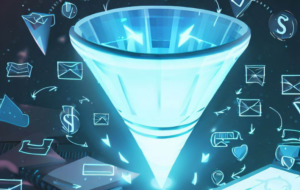
In the early 2000s, one of my favorite shows on television was “CSI: Las Vegas.” I appreciate how the producers have made something as tedious as forensic science both sexy and compelling. As a marketer, our job is to “sell” sexy, yet we must rely heavily on data and process to achieve the desired ROI. In an unending quest to improve the efficacy of our digital marketing efforts, I’ve developed a new methodology that combines the powerful analytics behind CSI forensic DNA research with the tried-and-true sales and marketing funnel.
Putting the “fun” in the sales funnel
Before jumping into the methodology behind fingerprinting digital marketing DNA, let us first talk about the sales and marketing funnel. Marketers of merit are intimately familiar with the traditional sales funnel: Awareness, interest, intent, and purchase. To successfully convert a new customer, you must take them through the sales and marketing process, from initial awareness to purchase.
We rely on the funnel methodology when developing digital marketing strategies, as each step of the sales process must be properly addressed to generate customers. While there are many variations in nomenclature around the number of stages or names in the sales funnel, I’ve felt there is a universal weakness among them all: they don’t address the customer as a marketer and sales driver.
At my former agency, Anvil, 40 percent of our new revenue was generated by our existing clients, in the form of new projects and referral business. That number far overshadowed our other sales and marketing activities. As such, I felt the need to factor happy clients into the traditional funnel. The net result is a new, upgraded sales funnel; one that incorporates customer evangelists, not only as a final stage but as the most important stage of the sales process.
As marketers, you should focus your efforts on targeting prospects which have the greatest likelihood of becoming evangelists, then structure your efforts, and that of the business, around them. For example, ensure your customer-facing employees are professionally trained to identify happy (and unhappy) customers and empower them to become evangelists for your brand. Reward employees that regularly delight customers; your business will thrive as a result.
Digital marketing DNA methodology
Now that you understand the evangelist stage, we can introduce the concept of digital marketing DNA. Every company has unique marketing fingerprints, and understanding those fingerprints provides powerful insights and opportunities to further enhance overall ROI. The “fingerprint” is created by assessing current marketing programs, both digital and traditional, across the entire sales funnel, based on efficacy. For simplicity’s sake, the analysis assumes all disciplines have full potential regardless of the stage of the cycle.
While the process and output are not an exact science, it will provide relative insights. Each discipline (i.e., search engine optimization, social media, or mobile marketing), is assessed for overall reach and efficiency for each stage of the funnel. To ensure the best possible results, you must create rules around evaluation criteria like “reach” and “efficiency.” For the following example, I used a qualitative barometer of “potential reach” and “potential efficiency” of each discipline on a scale of one through four (with four being the maximum.) With definitions in place, it’s time to follow the four-step analysis process outlined below.
Step one: Benchmark your marketing DNA.
The first step is to benchmark your current marketing efforts. Pick as many sales and marketing activities as possible or prudent (based on bandwidth and accessibility to data.) Assess the selected activities based on total investment as well as potential reach and efficacy across each stage of the funnel. As mentioned above, this is a qualitative exercise, but one that, if conducted properly, can yield powerful insights with the relative output.
In a theoretical example, I selected a subset that represents a typical digital marketing agency like Anvil, which included disciplines like search engine optimization (SEO) and pay-per-click (PPC), marketing automation, and public relations. In this example, each activity was assessed on a scale of one through four, where four implies maximum reach (relative to that discipline) and efficiency (campaigns are fully optimized.) As you can see, social media marketing and public relations (PR) are the strong points for this company. The evaluation is based on overall investment in the activities as well as sales data (lead source) for new business.
Advanced marketers may take this forensic audit to the next level, by tabulating scores for each stage, across disciplines (or even by discipline across stages). For example, using the one through four scoring scale as a percentage of total potential, the stages outlined above would score as follows:
- Awareness: 17/32 (53 percent)
- Interest: 18/32 (56 percent)
- Intent: 14/32 (44 percent)
- Purchase: 12/32 (38 percent)
- Evangelism: 15/32 (47 percent)
- Total: 76/160 (48 percent)
Step two: Benchmark the competition.
The second step is to conduct a competitive benchmark. For optimal results, consider benchmarking three to five competitors, including a mix of local, regional, and national companies. Select sales and marketing activities that can be efficiently and accurately measured. In the example below, I selected SEO, PPC, social, and PR, but you are welcome to incorporate other activities if you have the time and resources (marking sure to adjust your scoring accordingly.)
In a competitive benchmark example, you might see there are slight differences between the two competitors. Specifically, the SEO efforts may be more linear (which may be due to better product page design and lead capture.) Similarly, PPC efforts could be rated higher based on a larger media spend on targeted keywords and customized landing pages. Social media might perform better in the evangelism stage since the competitor is more effective at connecting with and engaging customers. PR is the one area where the competitor might not outperform the company benchmark, due to lack of focus or resulting coverage.
- Awareness: 11/16 (69 percent) vs. 10/16 (63 percent)
- Interest: 12/16 (75 percent) vs. 11/16 (69 percent)
- Intent: 9/16 (56 percent) vs. 7/16 (44 percent)
- Purchase: 6/16 (38 percent) vs. 5/16 (31 percent)
- Evangelism: 8/16 (50 percent) vs. 7/16 (44 percent)
- Total: 46/80 (58 percent) vs. 39/80 (49 percent)
For advanced marketers keeping score, the competitor outperformed the sample company by 58 percent to 49 percent. Repeat this process for two to four more competitors and see how you stack up.
Step three: Set a target benchmark.
Once you’ve assessed your competition, you should have a clever idea of where you want or need to be in terms of the ideal funnel. As the adage goes, you don’t have to outrun the bear to stay alive, you just must outrun the person next to you. Translating that to the funnel, ensure your resources are properly deployed to create the most robust and competitive DNA profile possible. The goal is to have a target of at least 50 percent potential across all stages of the funnel, including all activities.
In the example target benchmark, the sample company has significantly beefed up all sales and marketing activities, most notably marketing automation. The company is clearly investing more in online and traditional advertising to be more competitive. With additional effort spent on user experience and conversion optimization, all activities see improvement in the purchase stage. Also note that some activities are inherently better at creating evangelists than others (PR and social being top performers.)
- Awareness: 24/32 (75 percent)
- Interest: 23/32 (72 percent)
- Intent: 20/32 (63 percent)
- Purchase: 18/32 (56 percent)
- Evangelism: 18/32 (56 percent)
- Total: 103/160 (64 percent)
Overall, the target benchmark for the sample company (64 percent) is a significant increase over the initial benchmark (48 percent). You may want to set a higher target benchmark for your company, but remember it’s about outrunning the competition, not the bear.
Step four: Schedule audits
The last step in the Sales Funnel Forensic Audit is to schedule additional audits at regular intervals to evaluate overall success. I recommend quarterly audits, as they offer the best balance between the need to deploy resources productively yet continue to measure progress towards the target benchmark.
- Awareness: 19/32 (59 percent)
- Interest: 22/32 (69 percent)
- Intent: 21/32 (66 percent)
- Purchase: 17/32 (53 percent)
- Evangelism: 18/32 (56 percent)
- Total: 97/160 (61 percent)
In the example above, the sample company has not met the (64 percent) target across the activity or funnel stage, but there is notable progress (61 percent.) If this were a real audit conducted over a three-to-six-month interval, I would say this is a significant achievement.
Conclusion
The above process was designed to create a deeper understanding of the sales funnel and how marketing activities impact the bottom line. Most importantly, marketers must understand that evangelists drive your business and determine the future health of the company (think Net Promoter Score.) By following the four steps outlined above, you will gain insights into the strengths and weaknesses of your current marketing mix and sales strategies and adjust accordingly. By measuring towards target goals over time, you will maximize the value of this exercise.
Conducting a sales funnel forensic audit isn’t for everyone. Data-driven marketers may find the evaluation process and criteria too subjective or relative. Intuitive marketers (like me) may find the data collection and analysis elements tedious. Regardless of your personality or resources, I highly recommend gaining a better understanding of your current marketing DNA fingerprint, particularly against your top competitors, as it will help provide critical insights that will alter your activities and lead to better overall ROI.




